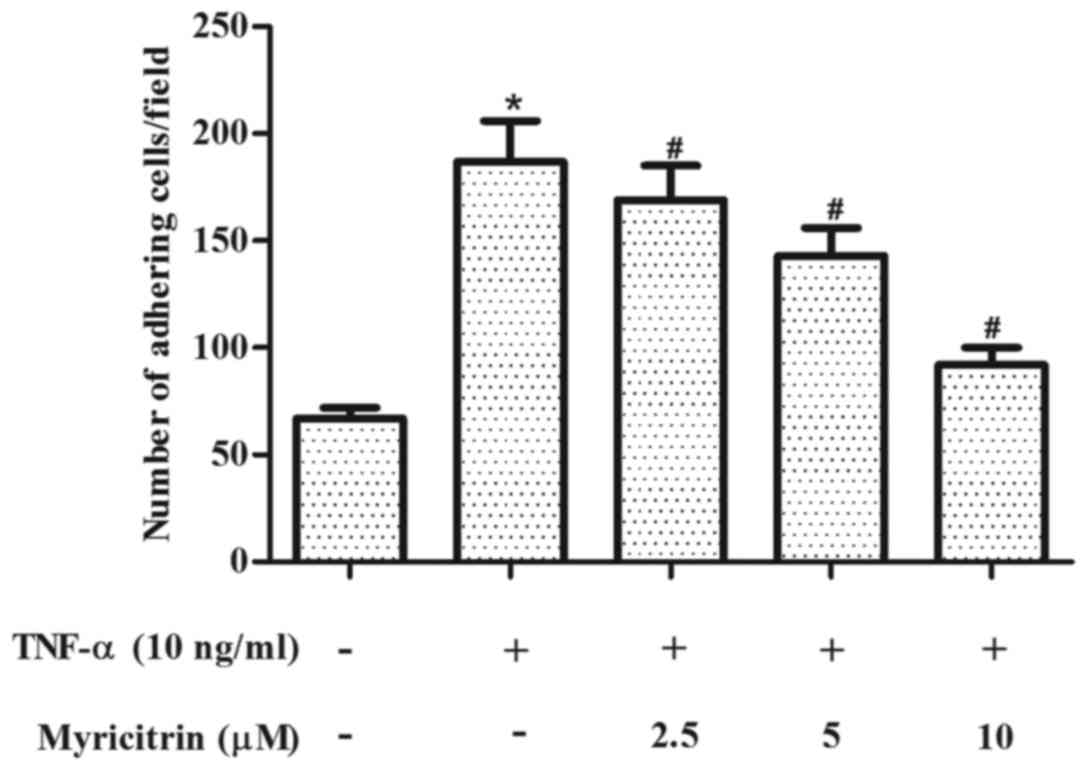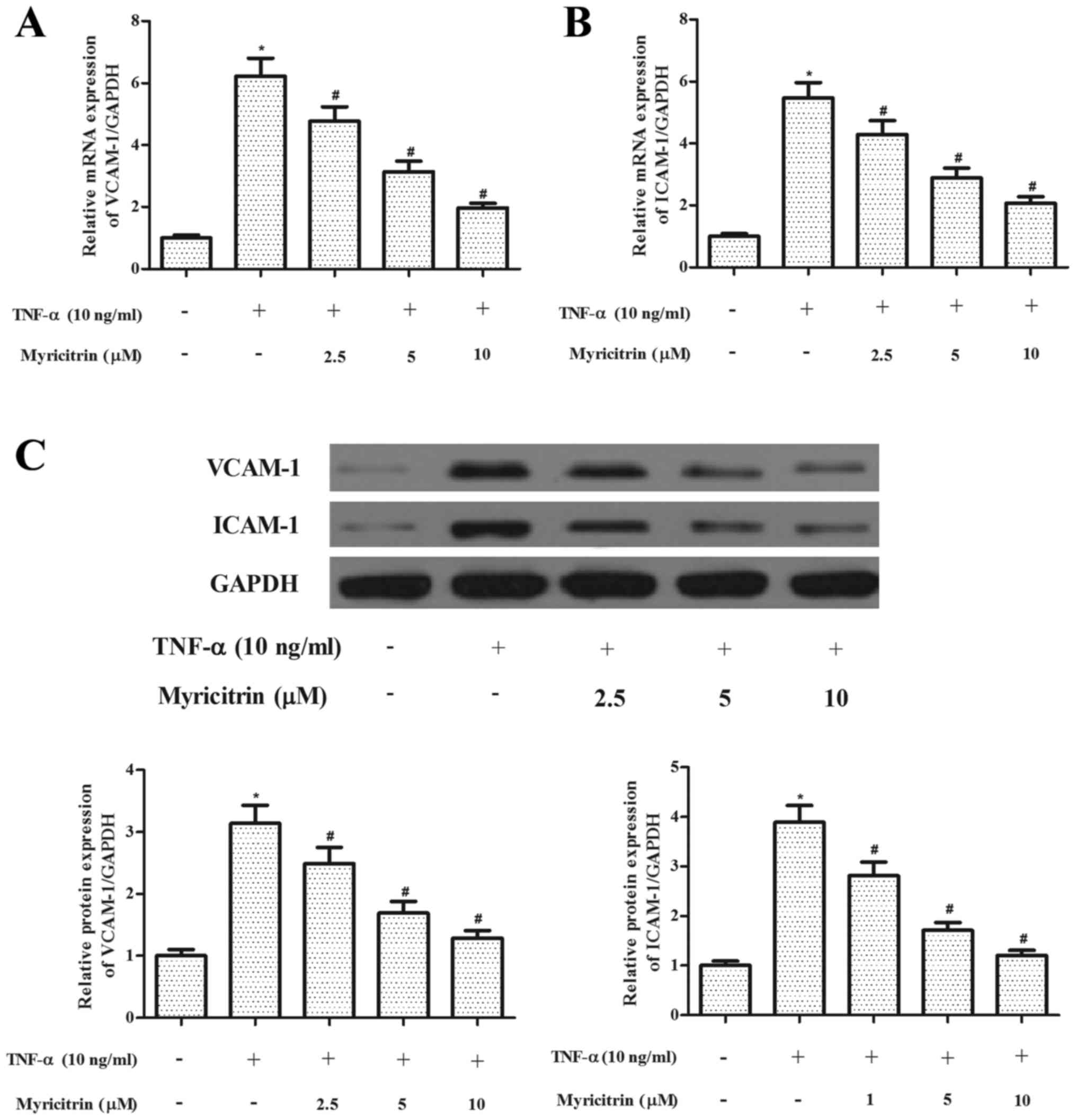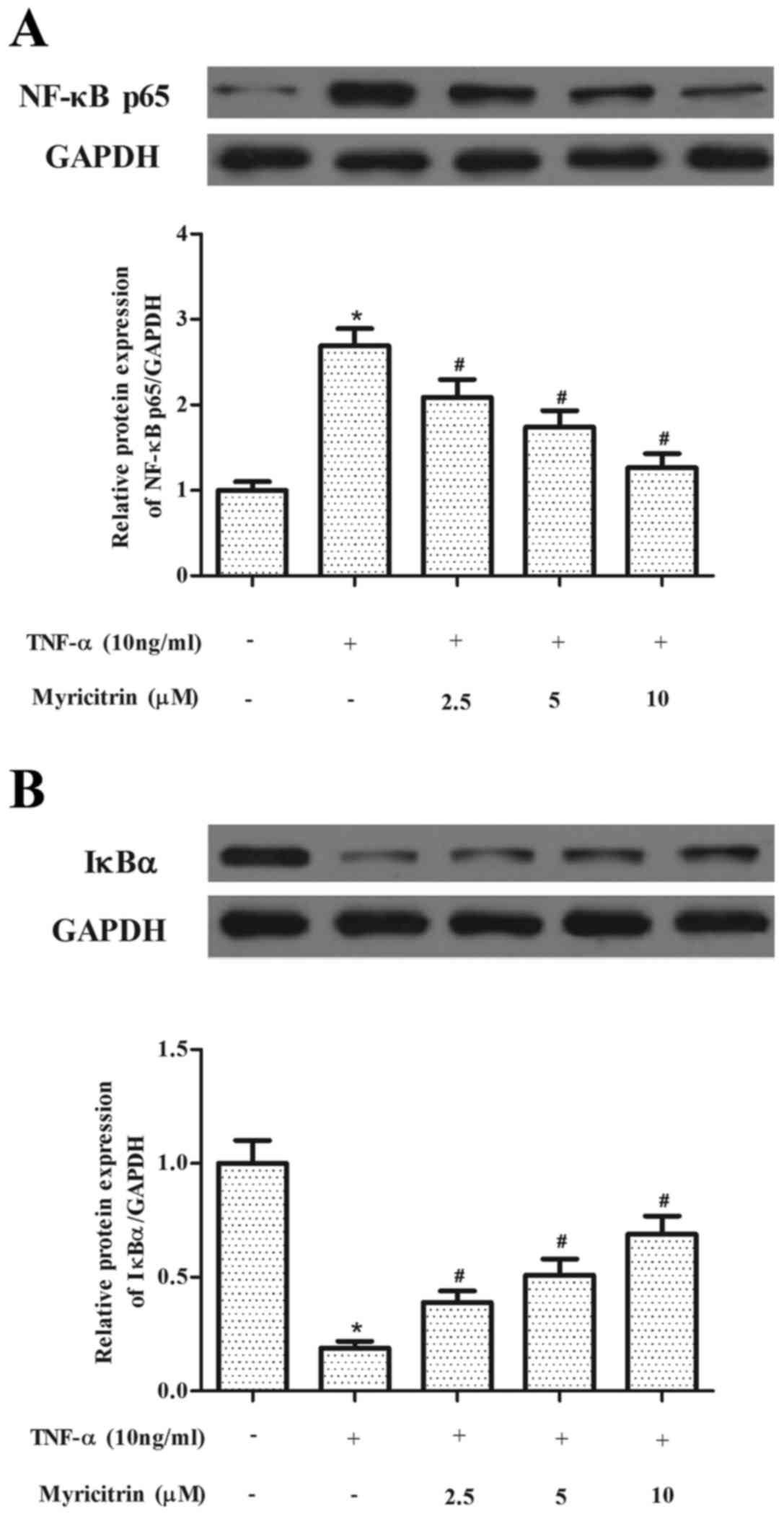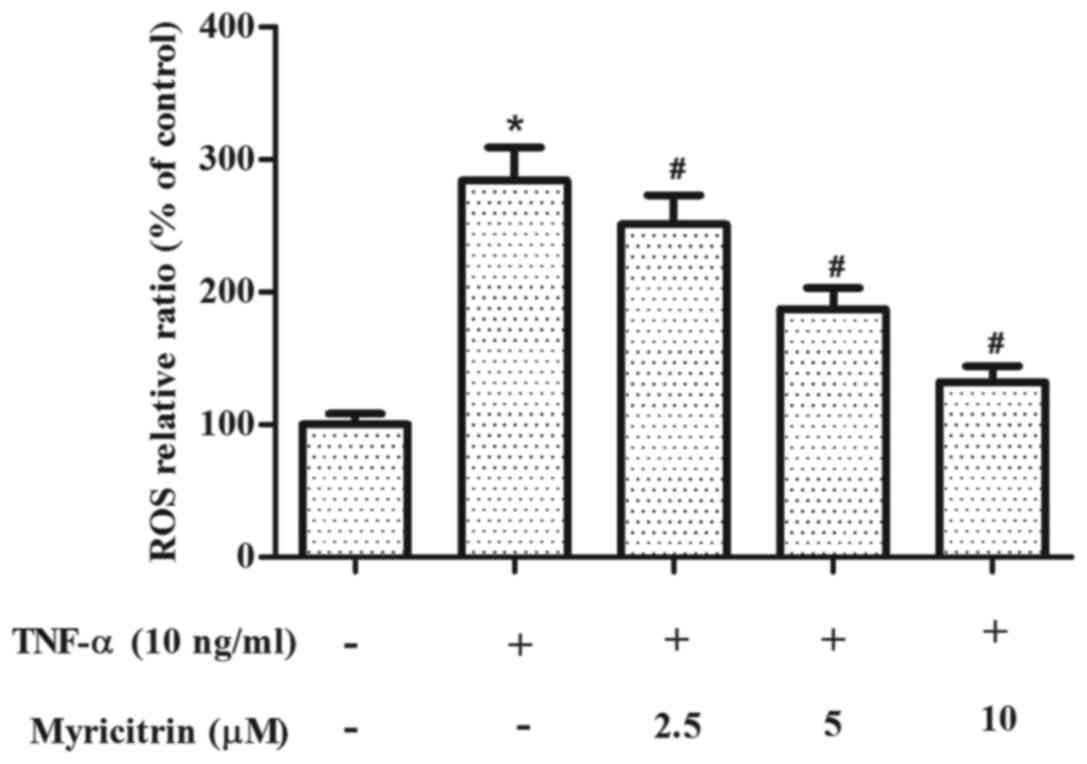Myricitrin inhibits vascular adhesion molecule expression in TNF‑α‑stimulated vascular smooth muscle cells
- Authors:
- Published online on: August 22, 2017 https://doi.org/10.3892/mmr.2017.7321
- Pages: 6354-6359
Abstract
Introduction
Atherosclerosis is the most common type of coronary artery disease and the leading cause of morbidity and mortality worldwide (1). It is characterized by the accumulation of lipids in the arterial vessel wall (2). A number of studies have demonstrated that the expression of cell adhesion molecules, such as intercellular adhesion molecule-1 (ICAM-1) and vascular cell adhesionmolecule-1 (VCAM-1), is increased in vascular smooth muscle cells (VSMCs), leading to increased neointima or atherosclerotic lesion formation (3–5). In addition, the expression of adhesion molecules in vascular cells is affected by inflammatory cytokines, such as tumor necrosis factor-α (TNF-α) (6). Therefore, a promising therapeutic approach for the treatment of pathological inflammation may be to reduce the expression of adhesion molecules in VSMCs.
Myricitrin, a bioactive compound of Myrica cerifera, has been demonstrated to exhibit a number of pharmacological actions, including antinociceptive, anti-inflammatory, anticancer and anti-oxidative activities (7–9). Domitrović et al (10) reported that myricitrin significantly reduced the carbon tetrachloride-induced increase in cyclooxygenase-2 and TNF-α levels in the liver. In addition, a previous study demonstrated that myricitrin exhibits anti-atherogenic effects (11). Administration of myricitrin in vivo decreased the vascular wall thickness of the aortic arch in apolipoprotein E−/− mice, and myricitrin treatment significantly attenuated oxidized low-density lipoprotein-induced endothelial cell apoptosis (11). However, the effect of myricitrin on the expression of adhesion molecules in VSMCs remains unknown. Therefore, the aim of the present study was to evaluate the inhibitory effects of myricitrin on adhesion molecule expression induced by TNF-α in VSMCs in vitro.
Materials and methods
Cell culture
The VSMC cell line MOVAS-1 was purchased from the American Type Culture Collection (ATCC; Manassas, VA, USA) and cultured in Dulbecco's modified Eagle's medium (Invitrogen; Thermo Fisher Scientific, Inc., Waltham, MA, USA) containing 10% fetal bovine serum (FBS; Gibco; Thermo Fisher Scientific, Inc.), 100 U/ml penicillin (Sigma; Merck KGaA, Darmstadt, Germany), 100 µg/ml streptomycin (Sigma; Merck KGaA), and 200 mM L-glutamine (Sigma; Merck KGaA) in a humidified 5% CO2 atmosphere at 37°C. THP-1 cells (ATCC) were maintained in RPMI-1640 (Invitrogen; Thermo Fisher Scientific, Inc.) supplemented with 10% FBS, 100 U/ml penicillin and 100 µg/ml streptomycin in an incubator with a humidified atmosphere of 5% CO2 at 37°C.
Cell adhesion assay
The cell adhesion assay was performed as previously described (12). Briefly, MOVAS-1 cells were plated in 96-well plates at a density of ~1×104 cells/well, which were then pretreated with varying concentrations (2.5, 5 and 10 µM) of myricitrin (Sigma; Merck KGaA) for 2 h, followed by stimulation with or without TNF-α (10 ng/ml; Sigma; Merck KGaA) for 8 h. The media was removed from the wells and 2′,7′-bis-(2-carboxyethyl)-5-(and-6)-carboxyfluorescein-labeled (5 µM; Sigma; Merck KGaA) THP-1 cells (1×105 cells/ml) in 0.2 ml medium were added to each well. Following incubation for 1 h at 37°C in 5% CO2, the wells were washed three times with 0.2 ml medium, and the number of adherent cells in 4 high power fields of view were observed using a Nikon Eclipse E600 fluorescence microscope at ×100 magnification (Nikon Corporation, Tokyo, Japan).
RNA extraction and reverse transcription-quantitative polymerase chain reaction (RT-qPCR)
Total RNA was extracted from MOVAS-1 cells (1×104 cells/well) with TRIzol reagent (Abcam, Cambridge, UK) according to the manufacturer's instructions. Total RNA (5 µg) was reverse transcribed into cDNA using an oligo-(dT) primer and M-MLV reverse transcriptase (Invitrogen; Thermo Fisher Scientific, Inc.) for qPCR analysis. qPCR was performed in a final volume of 10 µl, which consisted of 5 µl SsoFast™ EvaGreen Supermix (Bio-Rad Laboratories, Inc., Hercules, CA, USA), 1 µl cDNA (1:50 dilution) and 2 µl each of the forward and reverse primers (1 mM). The specific primers (Invitrogen; Thermo Fisher Scientific, Inc.) were as follows: VCAM-1 sense, 5′-CAAAGGTGGATCAGATTCAAG-3′ and antisense, 5′-GGTGAGCATTATCACCCAGAA-3′; ICAM-1 sense, 5′-CAAAGGTGGATCAGATTCAAG-3′ and antisense, 5′-GGTGAGCATTATCACCCAGAA-3′; GAPDH sense, 5′-CAAAGGTGGATCAGATTCAAG-3′ and antisense, 5′-GGTGAGCATTATCACCCAGAA-3′. The thermal cycling procedure was as follows: 95°C for 4 min, followed by 40 cycles of 95°C for 25 sec, 55°C for 30 sec and 72°C for 20 sec with 2 sec for plate reading, and melting curve analysis from 65 to 95°C. GAPDH was used as the control for normalizing gene expression. The relative quantification of the gene of interest was determined using the comparative ΔCq method (13).
Western blot analysis
MOVAS-1 cells (1×106 cells) were harvested, washed twice with phosphate-buffered saline, and lysed in radioimmunoprecipitation assay buffer (Cell Signaling Technology, Inc., Danvers, MA, USA) containing 100 mM NaCl, 50 mM Tris-HCl pH 7.5, 1% Triton X-100, 1 mM EDTA, 10 mM β-glycerophosphate, 2 mM sodium vanadate and protease inhibitors (Cell Signaling Technology, Inc.) on ice for 10 min. Following 15 min, 0.5% Nonidet P (NP)-40 (Mairybio; Beijing Minhai Biotechnology Co., Ltd., Beijing, China) was added to lyse the cells, which were vortexed for 10 sec. Then, cytosolic cell extracts were obtained following centrifugation at 1,500 × g for 10 min at 4°C. The collected nuclei were re-suspended in 50 µl of Buffer C [20 mM HEPES (pH 7.9), 1.5 mM MgCl2, 420 mM NaCl, 0.2 mM EDTA, 25% v/v glycerol, 0.5 mM PMSF and Protease Inhibitor Cocktail] and were then incubated on ice for 20 min with intermittent agitation. Nuclear cell extracts were obtained following centrifugation for 10 min at 13,000 × g and 4°C. Equal amounts (30 µg) of protein sample were separated using a 10% SDS-PAGE gel and then electrotransferred onto polyvinylidene difluoride membranes (EMD Millipore, Billerica, MA, USA). Following blocking in Tris-buffered saline buffer (50 mmol/l NaCl, 10 mmol/l Tris, pH 7.4) containing 5% non-fat milk for 1 h at room temperature, the membranes were then incubated with the appropriate primary antibodies against VCAM-1 (1:3,000; cat. no. sc-13160), ICAM-1 (1:3,000; cat. no. sc-8439), nuclear factor (NF)-κB p65 (1:2,000; cat. no. sc-8008), nuclear factor of κ light chain gene enhancer in B-cells inhibitor α (IκBα; 1:2,500; cat. no. sc-1643) and GAPDH (1:3,000; cat. no. sc-47724) at 4°C overnight, followed by incubation with a horseradish peroxidase-conjugated anti-rabbit IgG secondary antibody (1:3,000; cat. no. sc-2005; all from Santa Cruz Biotechnology, Inc., Dallas, TX, USA) for 1 h at room temperature. The membranes were exposed and visualized using enhanced chemiluminescence reagent (Thermo Fisher Scientific, Inc.). Densitometry was performed using Gel-Pro Analyzer software version 4.0 (Media Cybernetics, Inc., Rockville, MD, USA).
Measurement of intracellular reactive oxygen species (ROS) accumulation
Intracellular ROS levels were measured using dichlorofluorescein diacetate (DCFH-DA; Sigma-Aldrich; Merck KGaA,) staining. Briefly, MOVAS-1 cells (1×104 cells/well) treated with myricitrin in the presence or absence of TNF-α (as described in the Cell adhesion assay section) were incubated with 5 µM DCFH-DA for 30 min at 37°C in the dark, and were then washed with serum-free medium three times. The fluorescence intensity was measured at an excitation and emission wavelength of 485 and 520 nm, respectively, using a fluorescence spectrophotometer (Infinite M1000; Tecan Austria GmbH, Grödig, Austria). The ROS level was expressed as units of fluorescence.
Statistical analysis
The results were analyzed using SPSS software version 13.0 (SPSS, Inc., Chicago, IL, USA) and data are expressed as the mean ± standard deviation. Statistical significance was assessed by one-way analysis of variance followed by a Tukey post hoc test. P<0.05 was considered to indicate a statistically significant difference.
Results
Myricitrin inhibited the adhesion of THP-1 cells to TNF-α-stimulated MOVAS-1 cells
The effect of myricitrin on the adhesion of THP-1 cells to MOVAS-1 cells in response to TNF-α was first evaluated. As shown in Fig. 1, treatment of confluent MOVAS-1 cells with TNF-α for 8 h resulted in a 2.8-fold increase in the adhesion of THP-1 monocytic cells when compared with untreated MOVAS-1 cells (P<0.05). By contrast, pretreatment with myricitrin significantly inhibited the adhesion of THP-1 cells to TNF-α-stimulated MOVAS-1 cells in a dose-dependent manner (2.5 µM, P<0.05; 5 µM, P<0.05; 10 µM, P<0.05; Fig. 1).
Myricitrin inhibited the expression of adhesion molecules in TNF-α-stimulated MOVAS-1 cells
The increased expression of adhesion molecules is thought to serve an important role in the pathogenesis of atherosclerosis (4). Therefore, the present study investigated the effect of myricitrin on the expression of adhesion molecules in MOVAS-1 cells in response to TNF-α treatment. The RT-qPCR analysis results revealed that TNF-α significantly increased the mRNA expression levels of VCAM-1 and ICAM-1 in MOVAS-1 cells when compared with untreated controls. However, myricitrin significantly suppressed the mRNA expression levels of VCAM-1 and ICAM-1 in TNF-α-stimulated MOVAS-1 cells (VCAM-1, P<0.05; ICAM-1, P<0.05; Fig. 2A and B). In addition, myricitrin significantly suppressed the protein expression levels of VCAM-1 and ICAM-1 in TNF-α-stimulated MOVAS-1 cells (P<0.05 and P<0.05, respectively; Fig. 2C).
Myricitrin suppressed TNF-α-induced NF-κB activation in MOVAS-1 cells
NF-κB has been reported to serve a critical role in the regulation of adhesion molecule expression (14). Therefore, the present study investigated the effects of myricitrin on NF-κB activation in MOVAS-1 cells in response to TNF-α treatment. As indicated in Fig. 3, TNF-α significantly increased NF-κB p65 protein expression and IκBα degradation (NF-κB, P<0.05; IκBα, P<0.05). However, myricitrin pretreatment significantly prevented the TNF-α-induced increase in NF-κB p65 and the TNF-α-induced degradation of IκBα in MOVAS-1 cells in a dose-dependent manner (NF-κB, P<0.05 at 2.5, 5 and 10 µM myricitrin; IκBα, P<0.05 at 2.5, 5 and 10 µM myricitrin; Fig. 3).
Myricitrin inhibited ROS production in TNF-α-stimulated MOVAS-1 cells
ROS is involved in the development of atherosclerosis (15). Therefore, the present study examined the effect of myricitrin on ROS production in MOVAS-1 cells in response to TNF-α. As shown in Fig. 4, treatment with TNF-α significantly increased the production of ROS when compared to that of the untreated control cells (P<0.05). By contrast, pretreatment with myricitrin significantly inhibited TNF-α-induced ROS production in MOVAS-1 cells in a dose-dependent manner (2.5 µM, P<0.05; 5 µM, P<0.05; 10 µM, P<0.05; Fig. 4).
Discussion
To the best of the authors' knowledge, the present study is the first to delineate the effects of myricitrin on the expression of adhesion molecules in TNF-α-stimulated MOVAS-1 cells. The results indicated that myricitrin inhibits the adhesion of THP-1 cells to TNF-α-stimulated MOVAS-1 cells, as well as the expression of adhesion molecules. The underlying mechanism may involve the NF-κB signaling pathway.
Leukocyte adhesion to VSMCs during atherosclerotic progression is primarily mediated by cell adhesion molecules, such as VCAM-1 and ICAM-1 (16). It has been demonstrated that VCAM-1 and ICAM-1 are expressed by VSMCs and are prominent in the fibrous caps of advanced atherosclerotic plaques (17). In addition, a number of studies have reported increased expression of VCAM-1 and ICAM-1 in coronary atherosclerotic tissues (18,19). Furthermore, inflammatory cytokines, such as interleukin-1β and TNF-α, may induce the expression of VCAM-1 and ICAM-1 in VSMCs (20–22). In accordance with previous reports, the present study demonstrated that TNF-α significantly increased the adhesion of THP-1 cells to MOVAS-1 cells and the expression of VCAM-1 and ICAM-1 in MOVAS-1 cells. By contrast, myricitrin inhibited the adhesion of THP-1 cells to TNF-α-stimulated MOVAS-1 cells, as well as the expression of VCAM-1 and ICAM-1. These results indicate that myricitrin may exhibit an inhibitory effect on the expression of adhesion molecules in TNF-α-stimulated MOVAS-1 cells.
The NF-κB signaling pathway serves a critical role in the regulation of adhesion molecule expression (23,24). Translocation of NF-κB to the nucleus is preceded by the phosphorylation, ubiquitination and proteolytic degradation of IκBα (25). It has been reported that activation of the NF-κB transcription factor by TNF-α is required for the transcriptional activation of muscle cell adhesion molecules (26,27). Furthermore, a previous study reported that oral treatment with myricitrin induced anti-inflammatory effects in dextran sulfate sodium-induced acute colitis in mice by inhibiting Akt/phosphatidylinositol-3 kinase-dependent phosphorylation and the NF-κB signaling pathway (28). In addition, myricitrin was able to prevent the formation of advanced glycation end products by suppressing NF-κB activation and translocation triggered by methylglyoxal in SH-SY5Y cells (29). Similarly, myricitrin pretreatment prevented NF-κB p65 activation and IκBα degradation in TNF-α-stimulated MOVAS-1 cells in the present study. Therefore, these data indicate that the inhibitory effect of myricitrin on the expression of adhesion molecules may be mediated, in part, through suppression of the NF-κB signaling pathway.
ROS, which are synthesized by nicotinamide adenine dinucleotide phosphate oxidase, serve as secondary messengers that activate a number of signaling pathways, including the NF-κB pathway (30). Activation of these signaling cascades leads to the induction of various genes that serve critical roles in the development of atherosclerosis (31). In addition, it has been reported that TNF-α induces ROS production in VSMCs (20,32,33). The present study demonstrated that TNF-α significantly increased the production of ROS in MOVAS-1 cells. By contrast, pretreatment with myricitrin significantly inhibited ROS production in a concentration-dependent manner. These results indicate that myricitrin may inhibit the activation of NF-κB via suppression of ROS production in TNF-α-stimulated MOVAS-1 cells.
In conclusion, myricitrin inhibited the expression of VCAM-1 and ICAM-1 in TNF-α-stimulated MOVAS-1 cells potentially via the NF-κB signaling pathway. Therefore, myricitrin may be an effective pharmacological agent for the prevention or treatment of atherosclerosis.
References
|
Zernecke A, Shagdarsuren E and Weber C: Chemokines in atherosclerosis: An update. Arterioscler Thromb Vasc Biol. 28:1897–1908. 2008. View Article : Google Scholar : PubMed/NCBI | |
|
Munro J and Cotran R: The pathogenesis of atherosclerosis: Atherogenesis and inflammation. Lab Invest. 58:249–261. 1988.PubMed/NCBI | |
|
Tschoepe D: Adhesion molecules influencing atherosclerosis. Diabetes Res Clin Pract. 30 Suppl:S19–S24. 1996. View Article : Google Scholar | |
|
Galkina E and Ley K: Vascular adhesion molecules in atherosclerosis. Arterioscler Thromb Vasc Biol. 27:2292–2301. 2007. View Article : Google Scholar : PubMed/NCBI | |
|
O'Brien KD, McDonald TO, Chait A, Allen MD and Alpers CE: Neovascular expression of E-selectin, intercellular adhesion molecule-1 and vascular cell adhesion molecule-1 in human atherosclerosis and their relation to intimal leukocyte content. Circulation. 93:672–682. 1996. View Article : Google Scholar : PubMed/NCBI | |
|
Huo Y and Ley K: Adhesion molecules and atherogenesis. Acta Physiol Scand. 173:35–43. 2001. View Article : Google Scholar : PubMed/NCBI | |
|
Wang Y, Chen P, Tang C, Wang Y, Li Y and Zhang H: Antinociceptive and anti-inflammatory activities of extract and two isolated flavonoids of Carthamus tinctorius L. J Ethnopharmacol. 151:944–950. 2014. View Article : Google Scholar : PubMed/NCBI | |
|
Xu R, Zhang Y, Ye X, Xue S, Shi J, Pan J and Chen Q: Inhibition effects and induction of apoptosis of flavonoids on the prostate cancer cell line PC-3 in vitro. Food Chem. 138:48–53. 2013. View Article : Google Scholar : PubMed/NCBI | |
|
Huang Q, Gao B, Wang L, Hu YQ, Lu WG, Yang L, Luo Z-J and Liu J: Protective effects of myricitrin against osteoporosis via reducing reactive oxygen species and bone-resorbing cytokines. Toxicol Appl Pharmacol. 280:550–560. 2014. View Article : Google Scholar : PubMed/NCBI | |
|
Domitrović R, Rashed K, Cvijanović O, Vladimir-Knežević S, Škoda M and Višnić A: Myricitrin exhibits antioxidant, anti-inflammatory and antifibrotic activity in carbon tetrachloride-intoxicated mice. Chem Biol Interact. 230:21–29. 2015. View Article : Google Scholar : PubMed/NCBI | |
|
Qin M, Luo Y, Meng XB, Wang M, Wang HW, Song SY, Ye JX, Pan RL, Yao F, Wu P, et al: Myricitrin attenuates endothelial cell apoptosis to prevent atherosclerosis: An insight into PI3K/Akt activation and STAT3 signaling pathways. Vascul Pharmacol. 70:23–34. 2015. View Article : Google Scholar : PubMed/NCBI | |
|
Chen C, Chou C, Sun Y and Huang W: Tumor necrosis factor alpha-induced activation of downstream NF-kappaB site of the promoter mediates epithelial ICAM-1 expression and monocyte adhesion. Involvement of PKCalpha, tyrosine kinase, and IKK2, but not MAPKs, pathway. Cell Signal. 13:543–553. 2001. View Article : Google Scholar : PubMed/NCBI | |
|
Livak KJ and Schmittgen TD: Analysis of relative gene expression data using real-tie quantitative PCR and the 2(-Delta Delta C(T)) method. Methods. 25:402–408. 2001. View Article : Google Scholar : PubMed/NCBI | |
|
Baker RG, Hayden MS and Ghosh S: NF-κB, inflammation, and metabolic disease. Cell Metab. 13:11–22. 2011. View Article : Google Scholar : PubMed/NCBI | |
|
Cheng JC, Cheng HP, Tsai IC and Jiang MJ: ROS-mediated downregulation of MYPT1 in smooth muscle cells: A potential mechanism for the aberrant contractility in atherosclerosis. Lab Invest. 93:422–433. 2013. View Article : Google Scholar : PubMed/NCBI | |
|
Rains JL and Jain SK: Hyperketonemia increases monocyte adhesion to endothelial cells and is mediated by LFA-1 expression in monocytes and ICAM-1 expression in endothelial cells. Am J Physiol Endocrinol Metab. 301:E298–E306. 2011. View Article : Google Scholar : PubMed/NCBI | |
|
Libby P and Li H: Vascular cell adhesion molecule-1 and smooth muscle cell activation during atherogenesis. J Clin Invest. 92:538–539. 1993. View Article : Google Scholar : PubMed/NCBI | |
|
Yang PY, Rui YC, Lu L, Li TJ, Liu SQ, Yan HX and Wang HY: Time courses of vascular endothelial growth factor and intercellular adhesion molecule-1 expressions in aortas of atherosclerotic rats. Life Sci. 77:2529–2539. 2005. View Article : Google Scholar : PubMed/NCBI | |
|
Davies MJ, Gordon JL, Gearing AJ, Pigott R, Woolf N, Katz D and Kyriakopoulos A: The expression of the adhesion molecules ICAM-1, VCAM-1, PECAM, and E-selectin in human atherosclerosis. J Pathol. 171:223–229. 1993. View Article : Google Scholar : PubMed/NCBI | |
|
Kim JY, Park HJ, Um SH, Sohn EH, Kim BO, Moon EY, Rhee DK and Pyo S: Sulforaphane suppresses vascular adhesion molecule-1 expression in TNF-α-stimulated mouse vascular smooth muscle cells: Involvement of the MAPK, NF-κB and AP-1 signaling pathways. Vascul Pharmacol. 56:131–141. 2012. View Article : Google Scholar : PubMed/NCBI | |
|
Choi KW, Park HJ, Jung DH, Kim TW, Park YM, Kim BO, Sohn EH, Moon EY, Um SH and Rhee DK: Inhibition of TNF-α-induced adhesion molecule expression by diosgenin in mouse vascular smooth muscle cells via downregulation of the MAPK, Akt and NF-κB signaling pathways. Vascul Pharmacol. 53:273–280. 2010. View Article : Google Scholar : PubMed/NCBI | |
|
Hakonarson H, Halapi E, Whelan R, Gulcher J, Stefansson K and Grunstein MM: Association between IL-1beta/TNF-alpha-induced glucocorticoid-sensitive changes in multiple gene expression and altered responsiveness in airway smooth muscle. Am J Respir Cell Mol Biol. 25:761–771. 2001. View Article : Google Scholar : PubMed/NCBI | |
|
Xia P, Gamble JR, Rye KA, Wang L, Hii CS, Cockerill P, Khew-Goodall Y, Bert AG, Barter PJ and Vadas MA: Tumor necrosis factor-alpha induces adhesion molecule expression through the sphingosine kinase pathway. Proc Natl Acad Sci USA. 95:14196–14201. 1998; View Article : Google Scholar : PubMed/NCBI | |
|
Zhang WJ and Frei B: Alpha-lipoic acid inhibits TNF-alpha-induced NF-kappaB activation and adhesion molecule expression in human aortic endothelial cells. FASEB J. 15:2423–2432. 2001. View Article : Google Scholar : PubMed/NCBI | |
|
Pahl HL: Activators and target genes of Rel/NF-kappaB transcription factors. Oncogene. 18:6853–6866. 1999. View Article : Google Scholar : PubMed/NCBI | |
|
Collins T, Read MA, Neish AS, Whitley MZ, Thanos D and Maniatis T: Transcriptional regulation of endothelial cell adhesion molecules: NF-kappa B and cytokine-inducible enhancers. FASEB J. 9:899–909. 1995.PubMed/NCBI | |
|
Beg AA, Finco T, Nantermet PV and Baldwin AS Jr: Tumor necrosis factor and interleukin-1 lead to phosphorylation and loss of I kappa B alpha: A mechanism for NF-kappa B activation. Mol Cell Biol. 13:3301–3310. 1993. View Article : Google Scholar : PubMed/NCBI | |
|
Schwanke RC, Marcon R, Meotti FC, Bento AF, Dutra RC, Pizzollatti MG and Calixto JB: Oral administration of the flavonoid myricitrin prevents dextran sulfate sodium-induced experimental colitis in mice through modulation of PI3K/Akt signaling pathway. Mol Nutr Food Res. 57:1938–1949. 2013. View Article : Google Scholar : PubMed/NCBI | |
|
Wang YH, Yu HT, Pu XP and Du GH: Myricitrin alleviates methylglyoxal-induced mitochondrial dysfunction and AGEs/RAGE/NF-κB pathway activation in SH-SY5Y cells. J Mol Neurosci. 53:562–570. 2014. View Article : Google Scholar : PubMed/NCBI | |
|
Zhang GG, Bai YP, Chen MF, Shi RZ, Jiang DJ, Fu QM, Tan GS and Li YJ: Asymmetric dimethylarginine induces TNF-alpha production via ROS/NF-κappaB dependent pathway in human monocytic cells and the inhibitory effect of reinioside C. Vascul Pharmacol. 48:115–121. 2008. View Article : Google Scholar : PubMed/NCBI | |
|
Griendling KK, Sorescu D, Lassègue B and Ushio-Fukai M: Modulation of protein kinase activity and gene expression by reactive oxygen species and their role in vascular physiology and pathophysiology. Arterioscler Thromb Vasc Biol. 20:2175–2183. 2000. View Article : Google Scholar : PubMed/NCBI | |
|
Zhang HS and Wang SQ: Salvianolic acid B from Salvia miltiorrhiza inhibits tumor necrosis factor-alpha (TNF-alpha)-induced MMP-2 upregulation in human aortic smooth muscle cells via suppression of NAD(P)H oxidase-derived reactive oxygen species. J Mol Cell Cardiol. 41:138–148. 2006. View Article : Google Scholar : PubMed/NCBI | |
|
Wang Z, Zhang Y, Li Y, Banerjee S, Liao J and Sarkar FH: Down-regulation of Notch-1 contributes to cell growth inhibition and apoptosis in pancreatic cancer cells. Mol Cancer Ther. 5:483–493. 2006. View Article : Google Scholar : PubMed/NCBI |













